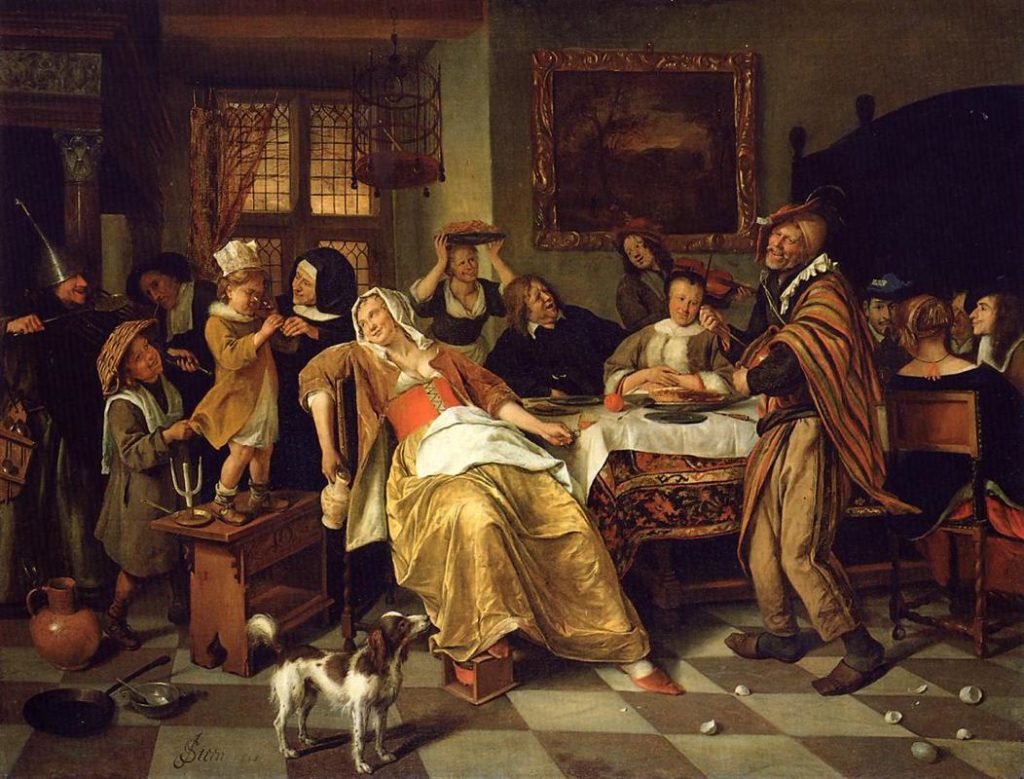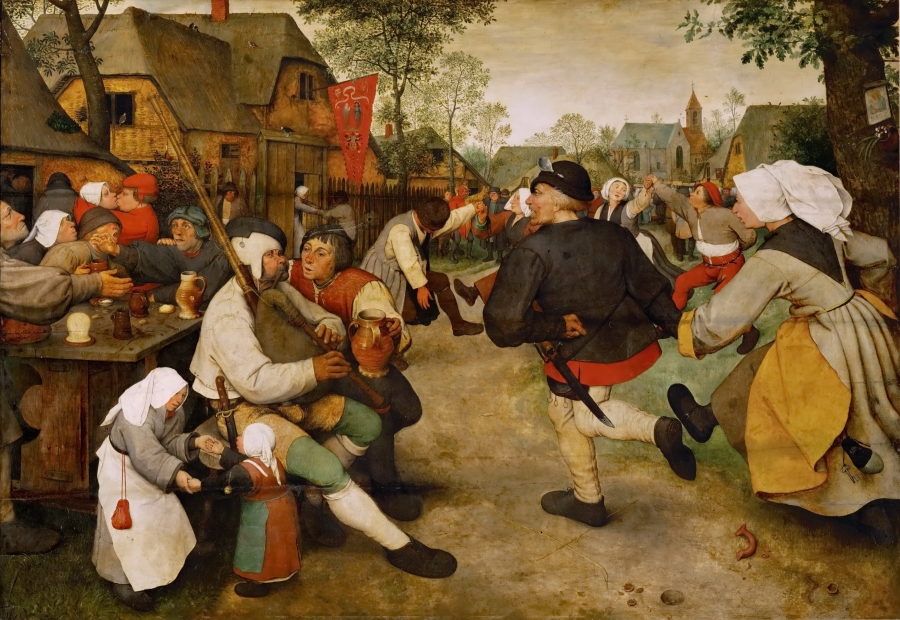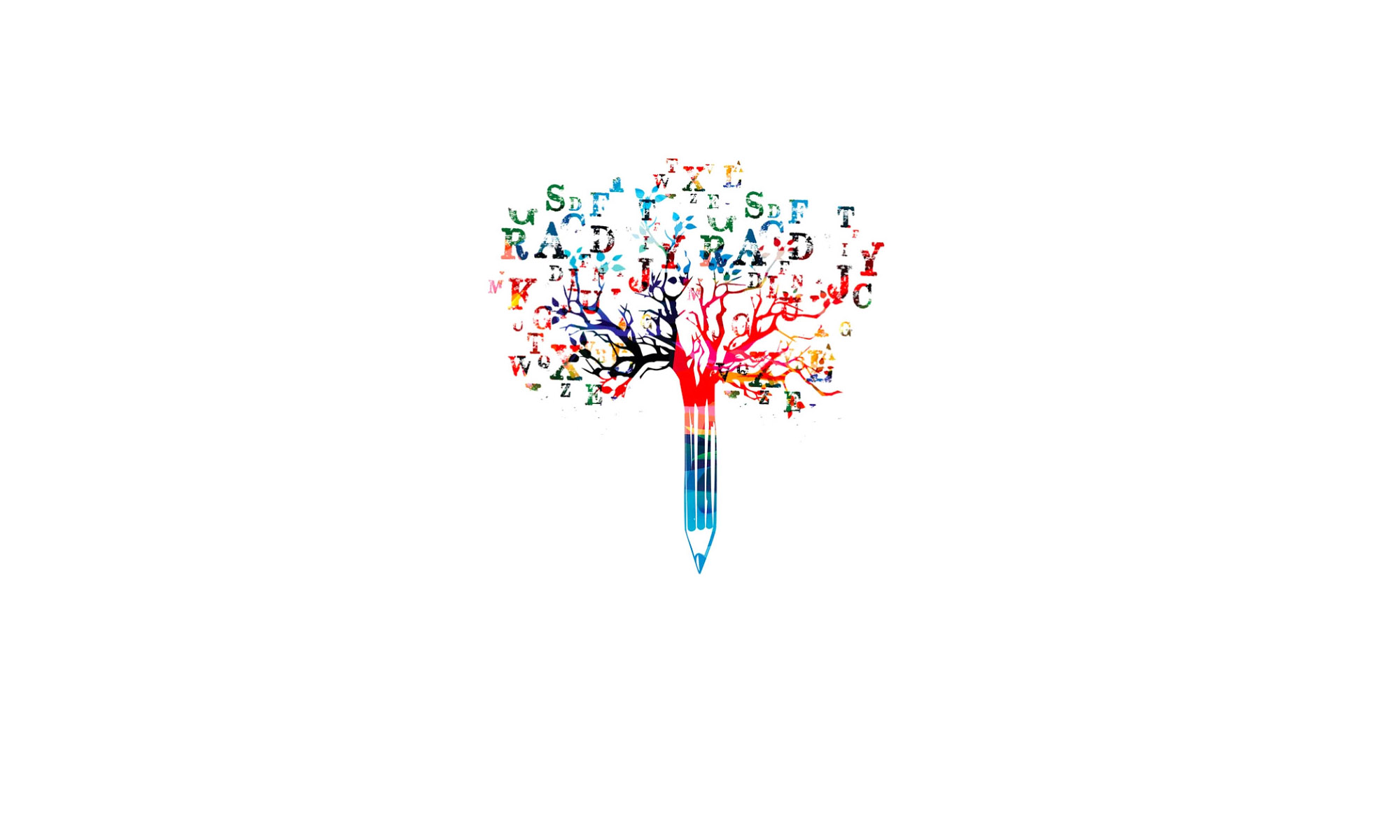Gamers and Revellers

Jan Steen, Twelfth Night (1668) . Kassel Old Masters Gallery in Wilhelmshöhe Castle, Germany
To conclude this section on the Dutch Golden Age, we will join the biggest party of all: genre painting (or the art of ‘vulgar realism’, as it has sometimes been called) – celebrations that were pioneered by Dutch painters. According to Anna Tummers, “It was no coincidence that it was in The Netherlands – and not elsewhere – that so many parties were painted. Art flourished on an unparalleled scale n this period and there was a market for paintings of recognizable figures and situations drawn fro everyday life. Capturing the atmosphere of festivities presented artists with interesting artistic challenges. But -perhaps even more significantly – an awful lot of partying really did go on.” 1
Paintings that depicted these parties began with Breughel’s peasant celebrations and later extended to depictions of celebrations to all classes of Dutch society. Not everyone was amused, of course, and these paintings did not sit well with eminent art historians, such as the 19th century critic, John Ruskin. In Modern Painters, Ruskin’s take on the genre leaves no doubt as to where he stands on the painters,”the various Van somethings with their debased obsessions with the pleasures of the ale house and the card table.’ He also leaves some of his ire for landscape painting (and, I take it, all of the other genres): ‘the effect of Dutch landscapes on the public mind is so totally evil that I conceive the best patronage that any monarch could possibly bestow upon the arts would be to collect the whole body of them into one gallery and burn it to the ground’. 2
What a loss this would have been to an entire genre of artworks that depict a range of Dutch festivities: from “peasant fairs and carnival celebrations to lavish el fresco parties, rhetoricians’ processions and civic guard banquets. These festive scenes often have a witty yet barbed undertone. Some depict infectiously-cheerful figures, costume balls and elegant etiquette, while others point up unbridled debauchery and comic contrasts between rich and poor. The functions of parties and the degree to which they were permissible were the subject of considerable debate in the seventeenth century.”3
Erasmus (1467 – 1536) took a more tolerant view to the Dutch and their celebrations, stating that “where morals and customs are concerned there is no nation that is more open to humanity and congeniality and less inclined to uncivilized and violent conduct. It is straightforward, is a stranger to disloyalty, deceit and serious vices, save perhaps that it loves entertainment and above all loves to celebrate. “4
These widely-differing responses to public celebration and partying and their depiction demonstrate the complexity of a society governed by the constrictions of Calvinism and yet one quite comfortable with a ‘pint or two’ and a good romp. It’s also this complexity which created challenges for the painters, such as Jan Steen, Jan Miense Molenaar, and Frans Hals, as well as Judith Leyster, who painted scenes of people singing or dancing, portraits of laughing people, domestic scenes, taverns and other places of entertainment which catered to the tastes and interests of a growing segment of the Dutch middle class that was eager to purchase art as part of their new social status. 5
In the next section, we will have a look at how two different poets (Philip Larkin and William Carlos Williams) depict scenes of revelry and games found in the paintings of Adriaan Brouwer and Pieter Brueghel.
Philip Larken: A game of Cards
 Adriaan Brouwer, The Card Players (first half of the 17th Century) . Royal Museum of Fine Arts, Antwerp
Adriaan Brouwer, The Card Players (first half of the 17th Century) . Royal Museum of Fine Arts, Antwerp
Philip Larkin’s poem paints the ultimate ‘guys night out’, where card playing provides the context for letting it all hang out. Indeed, from Jan’s first staggering image to his magnificent fart in the final lines, and everything in-between, we are drawn into the high spirit of the party – and into the painting itself. Larkin’s creation of a narrative for the painting and his delight in ‘getting down and dirty’ with colourful language brilliantly re-creates the feeling of these scenes, these ‘frozen moments’ which only come to life as we engage with the picture.
‘The Card Players’
Jan van Hogspeuw staggers to the door
And pisses at the dark. Outside, the rain
Courses in cart-ruts down the deep mud lane.
Inside, Dirk Dogstoerd pours himself some more,
And holds a cinder to his clay with tongs,
Belching out smoke. Old Prijck snores with the gale,
His skull face firelit; someone behind drinks ale,
And opens mussels, and croaks scraps of songs
Towards the ham-hung rafters about love.
Dirk deals the cards. Wet century-wide trees
Clash in surrounding starlessness above
This lamplit cave, where Jan turns back and farts,
Gobs at the grate, and hits the queen of hearts.
Rain, wind and fire! The secret, bestial peace!
(Collected Poems, London: Faber & Faber, 2003)
In this vivid re-creation of an example of genre painting, Larkin has ‘set himself against several centuries of received aesthetic opinion …melding the high art of poetry with the low art of genre painting and the language of the poem shows the extent to which Larkin ‘takes a child-like delight in transgression’.6 Just consider the verbs in the poem: stagger, piss, belch, fart, and gob (spit); is his use of colourful language, it is clear that Larkin is enjoying the party as much as the characters in the painting – and yet …. there is the ever-present reminder of death (memento mori) that we witnessed in Still Life Paintings: the gentle reminder of mortality in the midst of a rollicking good time, is depicted in Old Prijk’s ‘skull face’ and the starless night that hovers over the scene. Throwing one more wet blanket on the party, Larkin reminds us that these scenes do not reflect Man at his best, the ‘lamplit cave’ suggesting that the scene harks back to our primitive ancestry, a sentiment punctuated by his remarkable final line. Poetic form plays an important role here in understanding the significance of this final line: notice that the poem is a sonnet – although a rather irregular one, where the iambic pentameter of the sonnet (5 beats/line) is already broken in the first line to imitate Jan’s drunken stagger. Also, the expected volta (the about-face that serves to comment on the preceding lines) occurs late in the poem (line 14), and comments on the primitive bestiality of the scene that has just been described.
Ekphrastically speaking: It has probably not gone unnoticed that Jan van Hogspeuw is very active in this ‘painting’: he “staggers to the door”, “pisses into the dark” – not to mention his final two achievements in lines 12-13. This is, of course, impossible to represent in a single painting (as we know, paintings are frozen narratives). We can’t really hear Old Prijk snoring or singing ‘scraps of songs’, we can’t possibly know if Dirk is pouring himself ‘some more’. The painting depicted here – most probably the Adriaan Brouwer – has been set into motion, an animation that seems to incorporate the imagery of many paintings included in the sub-genre of ‘Card Playing’. The description of the scene and its cast of characters is vivid and quite detailed of genre types. We can zero in on the sub-genre thanks to the title ‘Card Players’. But in general, the ekphrastic nature of the poem lies in the fact that it addresses the excesses that are found in many genre paintings, and so (according to the Differential Model), could be called ‘Associative’, as it deals with topics associated with the genre.
William Carlos Williams, ‘The Kermis’

Pieter Breugel the Elder, The Village Kermis (1567). Kunsthistorisches Museum, Vienna
Williams’ poem is a wonderful panegyric to one of Pieter Brueghel’s peasant paintings. As we discussed in an earlier chapter, Brueghel was the first artist to depict peasants favourably and to raise their celebrations to art. Some critics would disagree – some suggesting that this painting shows peasants at their worst: ignoring the church in the far background and instead spending this religious holiday in front he pub (which Brueghel has made prominent in the painting). Notice also the excessive drinking and love-making going on in the background. But Williams has focussed on the most remarkable aspect of this painting: the depiction of movement, an innovation followed by other artsts of his time. According to Mickael Bouffard-Veilleuz and Herman Roodenburg (Celebrating in the Golden Age), they also copied his parade of characters, ” all those drinking, dancing and even urinating peasants and their women – in bent, contorted positions. The reveller (for that is all we ever see) are usually bent over, their shoulders are hunched and they turn their heads in all directions. ” The authors go on to say that “genre painting was all about movement’ and the question was how to portray ‘a dancing body in a medium that is by definition unmoving, that can only freeze motion. Painters explored how to depict that motion, often choosing ‘the specific moment when the body is not longer in balance, when the dancer has already lifted one leg. The viewer feels that the body is moving because the law of gravity dictates that this unstable position must flow into a different position. That is why countless painters have favoured precisely this step – with the moving boy supported on one foot – of of all the real and imaginary dance steps that there might be. Here a gain, Brueghel’s work was probably a major influence. In his Peasant Dance, for instance, the dancing men have flung their legs up with abandon.” 7
Williams’ ekphrastic poem on this painting reflects, indeed, imitates, the sheer joy and abandonment of the village dance, the motion of the ‘romp’ and the blare of instruments that complete the picture of a peasant celebration.
The Kermess
In Brueghel’s great picture, The Kermess, the dancers go round, they go round and around, the squeal and the blare and the tweedle of bagpipes, a bugle and fiddles tipping their bellies (round as the thick- sided glasses whose wash they impound) their hips and their bellies off balance to turn them. Kicking and rolling about the Fair Grounds, swinging their butts, those shanks must be sound to bear up under such rollicking measures, prance as they dance in Brueghel’s great picture, The Kermess.
First of all, the celebrants in the poem seem to be in perpetual motion: they “go round, they go round and/ around” to the “squeal and the blare and the/ tweedle of bagpipes.” In their portliness, they tip “their bellies” (and they might be a little tipsy), kicking and rolling about/ the Fair Grounds, swinging their butts” to the “rollicking measures,” they “prance as they dance.” Yet this seemingly formless abandon is shaped through the traditional, communal forms of the folk dance just as, through the discipline of language and measure, the poem is given form and structure. Brueghel achieves his movement by putting his characters off-balance in an otherwise ‘frozen moment’ – ‘the specific moment when the body is not longer in balance, when the dancer has already lifted one leg’ as pointed out by Bouffard-Veilleuz and Herman Roodenburg, Williams achieves this with the repetition of sounds that suggest the dancers are slightly out of control of their movements, as they go ’round, go round, and around’, ‘kicking and rolling’, their ‘bellies off balance’. The spirit of Brueghel’s painting is not only re-created by concrete visual images but also by auditory images: the sounds of the fairground are audible: they squeal and blare and we can hear the ‘tweedle of bagpipes, bugle and fiddles’.
Ekphrastically speaking: Notice that Williams has put his poem within a verbal frame (as we saw in his ‘Hunters in the Snow’, in an earlier chapter. In this way, he leaves no doubt as to source painting, the first and final lines reading ‘In Brueghel’s great picture, The Kermess’. As the name of the painting is also mentioned in the title, we can safely say that the poem is highly attributive (differential model), as it directly names its source, not once but three times. The rest of the poem is highly depictive, in the sense that it describes the motions of the dancing peasants as well as their appearance. The rest of the painting is left out of the poem: Williams’ focus is the representation of motion that was so wonderfully depicted in the painting. In this case, we can say that the poem is also a structural analogue (Differential model), as it attempts to reproduce the sense of motion created by the painting.
The poems of Larkin and Wlliams, though both ekphrastic, take quite different views of the rollicking folk. Larkin delights in the crudeness of the event, seemingly from a safe distance – and passes judgment in the final lines (perhaps in keeping with Ruskin’s appraisal of genre painting). Williams shares in the joy of the dance; notice that he does not pass judgment, although there is enough in the painting that might call for it (drunkenness and public lovemaking, for example). These different approaches reflect the complexity of genre painting and the different views of celebrations and gaming in the Dutch Golden Age.
NOTES
1. Anna Tummers, “Pioneers, Moralists, and Drunkards: Celebrating in the Golden Age”, in: Celebrating in the Golden Age, (Frans Hals Museum, NAi Publishers, 2011), p.8-19).
2. Modern Painters, 1843-60
3. Karel Schampers, Director Frans Hals Museum, Foreword, Celebrating in the Dutch Golden Age (Foreword).
4. Tummers, ibid, p9
5. If you would like to hear more about Leyster, here is an excellent website for a video recording: https://www.khanacademy.org/humanities/monarchy-enlightenment/baroque-art1/holland/v/leyster-self .
6. John Osborne, Radical Larkin: Seven Types of Technical Mastery (Springer, 2016)
7. Mickael Bouffard-Veilleuz and Herman Roodenburg, “Footwork: How Seventeenth-Century painters Made Their Merrymakers Dance” , Celebrating in the Golden Age, p. 29-31.
